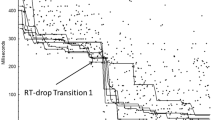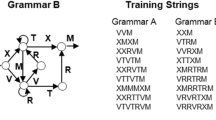Abstract
Is sequence learning an autonomous process that relies on independent resources? In this paper, I attempt to answer this question by exploring whether sequence learning occurs even despite the availability of reliable explicit information about the material to be learned. I report on a series of experiments during which participants performed a sequential choice reaction task. On each trial, participants were exposed to a stimulus and to a cue of varying validity which, when valid, indicated where the next stimulus would appear. Participants could therefore optimize their performance either by implicitly encoding the sequential constraints contained in the material or by explicitly relying on the information conveyed by the cue. Some theories assume that implicit learning does not rely on the same processing resources as those involved in explicit learning. Such theories would thus predict that sensitivity to sequential constraints should not be affected by the presence of reliable explicit information about sequence structure. Other theories, by contrast, would predict that implicit learning would not occur in such cases. The results are consistent with the former theories, but simulation work meant to enable the implications of these contrasting theories to be explored suggests that such results are also obtainable in architectures in which two processing pathways share resources.
Similar content being viewed by others
References
Berry, D. C., & Broadbent, D. E. (1988). Interactive tasks and the implicit-explicit distinction, British Journal of Psychology, 79, 251–272.
Berry, D. C., & Dienes, Z (1993). Implicit learning: Theoretical and empirical issues. Hove, England: Erlbaum.
Bertelson, P. (1961). Sequential redundancy and speed in a serial two choice responding task. Quarterly Journal of Experimental Psychology, 13, 90–102.
Cleeremans, A. (1993a). Mechanisms of implicit learning: Connectionist models of sequence processing. Cambridge, MA: MIT Press.
Cleeremans, A. (1993b). Attention and awareness in sequence learning. In Proceedings of the Fifteenth Annual Conference of the Cognitive Science Society (pp. 330–335). Hillsdale, NJ: Erlbaum.
Cleeremans, A. (1995). Implicit learning in the presence of multiple cues. In Proceedings of the Seventeenth Annual conference of the Cognitive Science society (pp. 298–303). Hillsdale, NJ: Erlbaum.
Cleeremans, A. (in press). Principles for implicit learning. In D. Berry (Ed.). What is implicit about implicit learning? Oxford, UK: Oxford University Press.
Cleeremans, A., & McClelland, J. L. (1991). Learning the structure of event sequences. Journal of Experimental Psychology: General, 120, 235–253.
Cohen, A., Ivry, R. I., & Keele, S. W. (1990). Attention and structure in sequence learning. Journal of Experimental Psychology: Learning, Memory and Cognition, 16, 17–30.
Curran, T., & Keele, S.W. (1993). Attentional and nonattentional forms of sequence learning. Journal of Experimental Psychology: Learning, Memory, and Cognition, 19, 189–202.
Elman, J.L. (1990). Finding structure in time. Cognitive Science, 14, 179–211.
Frensch, P., Buchner, A., & Lin, J. (1994). Implicit learning of unique and ambiguous transitions in the presence and absence of a secondary task. Journal of Experimental Psychology: Learning, Memory, and Cognition 20, 567–584.
Hyman, R. (1953). Stimulus information as a determinant of reaction time. Journal of Experimental Psychology, 45, 188–196.
Jiménez, L., Méndez, G., & Cleeremans, A. (1996). Direct and indirect measures of implicit learning. Journal of Experimental Psychology: Learning, Memory, and Cognition, 22, 948–969.
Knowlton, B. J., Ramus, S. J., & Squire, L. (1992). Intact artificial grammar learning in amnesia: Dissociation of classification learning and explicit memory for specific instances. Psychological Science, 3, 172–177.
Lewicki, P., Czyzewska, M., & Hoffman, H. (1987). Unconscious acquisition of complex procedural knowledge. Journal of Experimental Psychology: Learning, Memory, and Cognition, 13, 523–530.
Luce, R. D. (1963). Detection and recognition. In R. D. Luce, R. R. Bush, & E. Galanter (Eds.), Handbook of mathematical psychology: Vol. 1 (pp. 23–50). New York: Wiley.
Matzel, L. D., Schachtman, T. D., & Miller, R. R. (1985). Recovery of an overshadowed association by extinction of the overshadowed stimulus. Learning and Motivation, 16, 398–412.
Nissen, M. J., & Bullemer, P. (1987). Attentional requirements of learning: Evidence from performance measures. Cognitive Psychology, 19, 1–32.
Plaut, D. C. (1995). Double dissociation without modularity: Evidence from connectionist neuropsychology. Journal of Clinical and Experimental Neurospsychology, 17, 291–326.
Perruchet, P., & Amorim, P.A. (1992). Conscious knowledge and changes in performance in sequence learning: Evidence against dissociation. Journal of Experimental Psychology: Learning, Memory, and Cognition, 18, 785–800.
Reber, A. S. (1989). Implicit learning and tacit knowledge. Journal of Experimental Psychology: General, 118, 219–235.
Reber, A. S. (1990). On the primacy of the implicit: Comment on Perruchet and Pacteau. Journal of Experimental Psychology: General, 119, 340–342.
Reber, A. S. (1993). Implicit learning and tacit knowledge: An essay on the cognitive unconscious. Oxford, UK: Oxford University Press.
Reber, A. S., & Lewis, S. (1977). Implicit learning: An analysis of the form and structure of a body of tacit knowledge. Cognition, 5, 333–361.
Rescorla, R. A., & Wagner, A. R. (1972). A theory of Pavlovian conditioning: Variations on the effects of reinforcement and nonreinforcement. In A. H. Black & W. F. Prokasky (Eds.), Classical conditioning II (pp. 64–99). New York: Appleton Century-Crofts.
Shanks, D. R., & St. John, M. F. (1994). Characteristics of dissociable human learning systems. Behavioral and Brain Sciences, 17, 367–395.
Stadler, M.A. (1995). The role of attention in implicit learning. Journal of Experimental Psychology: Learning, Memory, and Cognition, 21, 674–685.
Author information
Authors and Affiliations
Rights and permissions
About this article
Cite this article
Cleeremans, A. Sequence learning in a dual-stimulus setting. Psychol. Res 60, 72–86 (1997). https://doi.org/10.1007/BF00419681
Received:
Accepted:
Issue Date:
DOI: https://doi.org/10.1007/BF00419681




